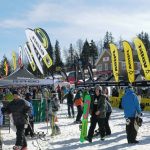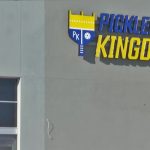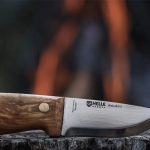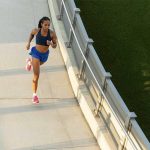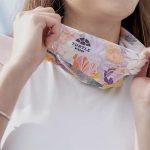Hibbett Sporting Goods, Inc. saw softness in urban in the first quarter slow overall growth, but a calendar shift that saw the first week of February move into the fiscal fourth quarter while the much softer first week of May moved into Q1 dragged quarterly comps into the red. On a like-for-like calendar basis, comparable store sales improved 0.7% after falling 0.7% in the same period last year. On that same calendar basis, sales of $133.8 million grew “approximately 10%.”
Company Chairman and CEO Mickey Newsome said that comps in their strip center doors were up 2.7% for the quarter, while the mall-based business comped down 2.1% on a conference call with analysts. Within the mall-based softness, the real culprits were stores in urban enclosed malls, which collectively were down 5% on a comp basis. Including strip center stores, urban stores comped down about 3%.
By month, February was down 4% on a comp store basis as the implementation of the companys new JDA merchandise software system caused an interruption to product flow during the first two weeks of the month. This interruption was compounded by softness in urban, especially in the aforementioned urban enclosed malls. March was said to be up 8% due to the shift in Easter as well as a return to normalcy following the JDA disruption. However, the Easter shift that benefited March slowed April to a comp decrease of 4%.
The footwear business was “up slightly” after the same gain in Q1 last year. Key drivers were youth footwear and the cleated business. Jeff Rosenthal, VP of merchandising, called out Nike, New Balance, Asics, and Heelys as key contributors. He said the “classic business and urban has continued to be soft with the exceptions of Jordans and Air Force Ones.” Rosenthal further noted that he expects kids and cleats to be “a major driver for the back to school season.”
In apparel, activewear sales were said to be up in the mid-single-digits, with growth driven by Under Armour, Nike and Adidas. Youth activewear was up double-digits, while mens and womens were both up in the high-single-digits. Rosenthal said the company anticipates similar results for activewear to play out for the remainder of the year. He also noted that urban apparel remained “tough,” but that it “should stabilize during back to school against softer comparisons.” The licensed apparel business was down in single-digits. College was said to be up low-single-digits, with HIBB expecting the category “to get stronger at back to school.” Pro apparel was down double-digits with “NBA being the worst performing category.”
The hardgoods business was down low-singles, due in large part to basketball and fitness, which were both down double-digits. Baseball was up low-singles and soccer was up high-singles. Rosenthal said the company expects “football will be a key driver in the second quarter with new products from Nike, Under Armour and Shock Doctor.”
The decrease in margins was attributed to the “deleveraging of store occupancy and warehouse costs,” while the company also experienced “a slight erosion in product margin rate.” In addition to these decreases, selling and administration costs increased from the prior year, which caused the double-digit decrease on the bottom line.
Hibbett opened a net of 7 new stores in Q1, opening 9 but closing 2, for a total of 620 doors in 23 states at the end of the quarter. HIBB plans to open approximately 90 to 95 new stores for the year while closing 5 to 10, including approximately 15 to 18 new stores in the second quarter, as well as 2 closings. Of the new store openings, more than 90% will be in strip centers.
The company anticipates maintaining a 14% to 15% net store growth rate for 2008 and 2009.
HIBB expects to report earnings per diluted share of approximately 20 cents to 24 cents for the second quarter on a comp store sales increase in the high-single-digits. The retailer sees diluted EPS in the $1.30 to $1.35 per share range for the year.
On the conference call reviewing the quarterly results, Newsome commented that he felt part of the reason behind the urban softness was a trend towards electronics amongst that consumer. “That urban consumer is all over electronics: iPods and cell phones. And we think thats part of it.” On the bright side, management sees marquee still doing well with the urban consumer as “Jordan launches were extremely good” and “key Air Force One launches were still very good,” said Rosenthal.
Commenting on the competition from Foot Lockers possible inventory clearance plans, Newsome said that “a little over 30%” of the companys stores are in enclosed malls with nearly all of those malls also having a Foot Locker. He said that should FL become even more promotional, HIBB will not “get in a battle with anybody on price.” In addition, Newsome said that as Dicks Sporting Goods begins to create more of a presence in the Southeast, he feels the move will not have that large of an effect on HIBB as Hibbett stores tend to be in smaller markets than can support DKS. Nonetheless, HIBB stores “typically get hit 15% year one and then start coming back,” when a big box store opens.
| Hibbett Sporting Goods | |||
| First Quarter Results | |||
| (in $ millions) | 2007 | 2006 | Change |
| Total Sales | $133.8 | $126.9 | +5.5% |
| Gross Margin | 33.7% | 34.8% | -110 bps |
| Net Income | $10.2 | $11.5 | -11.2% |
| Diluted EPS | 32¢ | 35¢ | -8.6% |
| Comps | -2.6% | -0.7% | |
| Inventory* | $133.4 | $116.1 | +14.8% |
| * at quarter-end | |||








